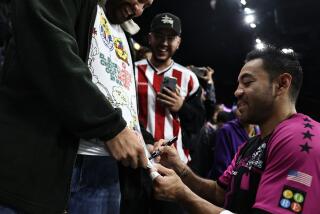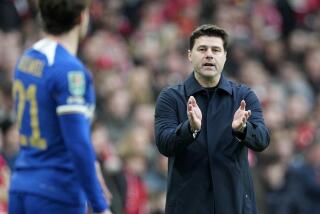He’s the McSorley of U.S. Soccer : World Cup: This game has its enforcers, too, and the Americans have John Stollmeyer.
- Share via
TIRRENIA, Italy — There is a saying in England that rugby is a sport for hooligans played by gentlemen, whereas soccer is a game for gentlemen played by hooligans.
That observation has been advanced by generations of rugby players, but despite their lack of objectivity, no one has taken exception.
In soccer’s First World countries of Europe and South America, the game in many cases is played by street urchins who turn professional as teen-agers, or at about the same time they drop out of school. Whatever success they will have for the rest of their lives depends largely on the success they have in their few productive years on the field.
So to say that many players in the World Cup are fighting for their lives, or at least their livelihoods, is not a gross exaggeration. Even if it were, they play as if their lives were at stake.
Unless Cameroon’s players have been training on the moon, they are aware that Argentina’s Diego Maradona has an ingrown toenail on the big toe of his right foot.
Cameroon’s starting 11, plus the two reserves, will not feel as if they have earned their paychecks in Friday’s opening game at Milan unless each of them has stepped on Maradona’s inflamed big toe at least twice.
It is a pity for Maradona that Argentina’s opener is not against the United States. To its players, he is Mr. Maradona. They not only would not step on his toe, they would help him cross the street to get to the game.
They are not hooligans. They are Boy Scouts. Having learned the sport on the suburban fields of the American Youth Soccer Organization, they have honed their skills at institutions of higher learning.
Not only is the United States the youngest team in the 24-team tournament, it is the most educated. The head coach taught history at the university level. The goalkeeper coach has his Ph.D. If this were the “GE College Bowl,” no one would be making fun of the U.S. team’s chances.
With all of that exposure to academia comes a certain amount of refinement, which is all too apparent when the United States plays soccer.
“In international tournaments, we always seem to win the fair-play award,” said midfielder Paul Caligiuri, a former UCLA co-captain who grew up in Diamond Bar.
For the uninitiated, that is like being named Miss Congeniality in a beauty contest. It is not an award for which the last U.S. team in the World Cup 40 years ago would have been a contender.
As head of the U.S. delegation, Walter Bahr, a midfielder on that team, has nothing but kind words for the current players. But he does note that most of the players in 1950 were from working-class, Central European immigrant families and approached the game with a tenacity that is not necessarily encouraged by AYSO.
Bahr recalled that the 1950 team had a professional carpenter and defender named Charley Colombo, who was tough as nails. Bahr said Colombo would tackle his own mother to save a goal, and it was his jarring takedown of Stanley Mortensen that saved the United States’ stunning 1-0 victory over England.
The closest the latest U.S. entry has to Colombo is John Stollmeyer, who, at 27, is the team’s oldest player.
As a defensive midfielder, it is his job to make sure that anyone who busts loose in the U.S. end of the field gets busted. He is the team’s middle linebacker.
“When I was younger, I was smaller than most other players,” said Stollmeyer, who is from Annandale, Va., and Indiana University. “I learned how to tackle, how to fight and how to get stuck in. My father used to tell me, ‘If you go in for a tackle half-hearted, you’re going to get hurt.’ So when I tackle, I tackle for keeps.”
That has not always made him a popular player in the United States.
“I don’t know how many times I’ve heard people say, ‘You don’t have to play that hard,’ ” he said.
“But that’s the only reason I’m here. I don’t have the speed or the skill of most of the other players. But I let the other team know that I’m out there.
“I want to establish an attitude in the first five minutes. The first tackle is to win. I’m telling my teammates, ‘I’m starting to play; you’d better start, too.’ ”
Unfortunately for the U.S. teams, Stollmeyer’s intensity is not always contagious.
“We have to get mean and aggressive,” forward Bruce Murray said Wednesday after the team’s morning workout. “We’re too clean.”
The sport’s governing body, the International Federation of Assn. Football (FIFA), would approve. It has warned World Cup referees that they will be suspended if they do not strictly enforce the rules.
Referees have been instructed to give yellow cards--two in one game lead to disqualification--to players who commit the so-called professional foul, which has been winked at in the past.
It also is called a tactical foul, which means that a player brings down an opponent in order to prevent him from becoming a scoring threat. Referees usually call a foul on the offending player but do not give him a yellow card unless he has displayed no finesse whatsoever in his tackle.
“We’re not coaching that in the United States,” said Ralph Perez, a U.S. assistant coach from Cal State San Bernardino. “That’s considered a dirty play. But to play at this level, we need some enforcers. You need a balance between dancers and guys who get stuck in.”
The United States needs more Stollmeyers.
And he will believe FIFA is getting tough when he sees it.
“They’re always telling us they’re cracking down on some of the fouling that goes on, but that’s part of the game,” he said. “It’s like trying to get fighting out of hockey.”







